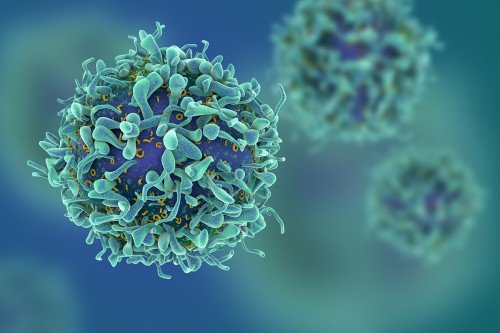
Pick up any immunology textbook and you’ll find an explanation of the “innate” and “adaptive” arms of the immune system. The innate arm is active from birth and responds to a predefined set of common threats; the adaptive arm takes time to develop but is more versatile at combatting new and unique threats.
In keeping with this division of labor, each immune arm also has its own specialized cellular workforce. The major innate immune cell is the natural killer (NK) cell, while the principal adaptive immune cells are T and B cells.
At least, that’s the conventional way of viewing things. A new study published September 24, 2021 in the journal Science Immunology from researchers at Memorial Sloan Kettering Cancer Center (MSK) complicates this tidy picture. A team led by physician-scientist Katharine Hsu has uncovered a ‘hybrid’ cell type that falls between these the innate and adaptive categories, and has qualities that make it an attractive candidate for immunotherapy
“These cells look like a cross between an NK cell and a T cell,” says Rosa Sottile, a postdoctoral fellow in the Hsu lab and lead author on the study. “They have the best of both worlds when it comes to killing power and stamina.”
Like T cells, the hybrid cells have receptors that can recognize specific invaders. But unlike T cells, they don’t make immune checkpoint molecules that cause immune cells to gradually shut down. So, in theory, these hybrid cells may be capable of fighting cancer for longer.
The study authors argue that hybrid cells could be a good target for immunotherapy. In particular, treatments that involve removing immune cells from a patient, growing them outside the body, and then giving them back in large numbers to fight cancer — like CAR T cell therapy — could get a boost.
Immune Cells with a “Double Sword”
The researchers made their discovery in the course of researching the immune response to human cytomegalovirus (CMV). This common and usually harmless virus is normally kept in check by a healthy immune system, but it can quickly turn lethal in people who are immunocompromised, such as those undergoing bone marrow transplants. Dr. Hsu is a member of the blood and bone marrow stem cell transplantation service at MSK.
By studying blood samples from transplant patients and healthy volunteers, the researchers could see that CMV infection is associated with a steep rise in a population of T cells that have certain NK cell-like attributes. A senior scientist in the Hsu lab, Jean-Benoit Le Luduec, was the first to notice this population of NK-like T cells that emerges after CMV infection.
These cells have some unique properties. For one, they make both NK cell-typical receptors for pathogens as well as T cell-typical receptors and therefore have access to two different means of killing. Dr. Sottile calls this a “double sword.”
To determine exactly what produces this change in identity, the researchers used an advanced technique called RNA seq (short for sequencing, and pronounced “seek”), which measures genes that are turned on in individual cells. What they found is that a particular protein in the T cells called BCL11B is shut down following CMV infection, and it’s the flipping of this genetic “switch” that causes T cells to become more like NK cells.
Knowing that BCL11B is responsible for the identity change raises the possibility that researchers could generate these NK-like T cells from someone who is not infected with CMV, and use them as a starting point for the creation of immunotherapy treatments.
“That’s why understanding the mechanism of this switch is so vital,” Dr. Hsu says.
Advantages of the Hybrid Cell Type
Cell-based immunotherapies like CAR T could be the first to readily benefit from the discovery. Currently FDA-approved versions of CAR T cells are made from a person’s T cells. But T cells are vulnerable to being deactivated by tumors that make a molecule PD-L1, which triggers the PD-1 checkpoint, or “brake,” on these immune cells.
Because the hybrid cell does not make PD-1, it is an attractive alternative as a starting point for CAR T and other cell-based immunotherapies.
Another perk of the cells is that they are less prone to recognizing off-target parts of the body, which can cause a dangerous complication called graft-versus-host disease (GVHD).
Dr. Hsu’s team is already making CAR cells with their newly discovered cell type, including ones that are specific for a marker on leukemia cells called CD19. These double-sworded cells seem more effective at killing cancer, compared with their single-sworded counterparts.
The Hsu lab is currently pursuing collaborations with adoptive cell therapy specialists Michel Sadelain, Chris Klebanoff, and others at MSK, and hopes to be able to bring these cells to cancer patients in the future.
Applications aside, Dr. Hsu and her colleagues are curious to find out more about this unusual cell type. “We’re slowly unveiling the secrets of this unique cell population that challenges our conventional understanding,” she says.
- The human immune system is conventionally divided into innate and adaptive arms, each with its own set of typical immune cells.
- A recently discovered ‘hybrid’ immune cell type has features of both natural killer cells (innate arm) and T cells (adaptive arm).
- These hybrid cells are less prone to exhaustion and therefore may make an ideal target for immunotherapy.




